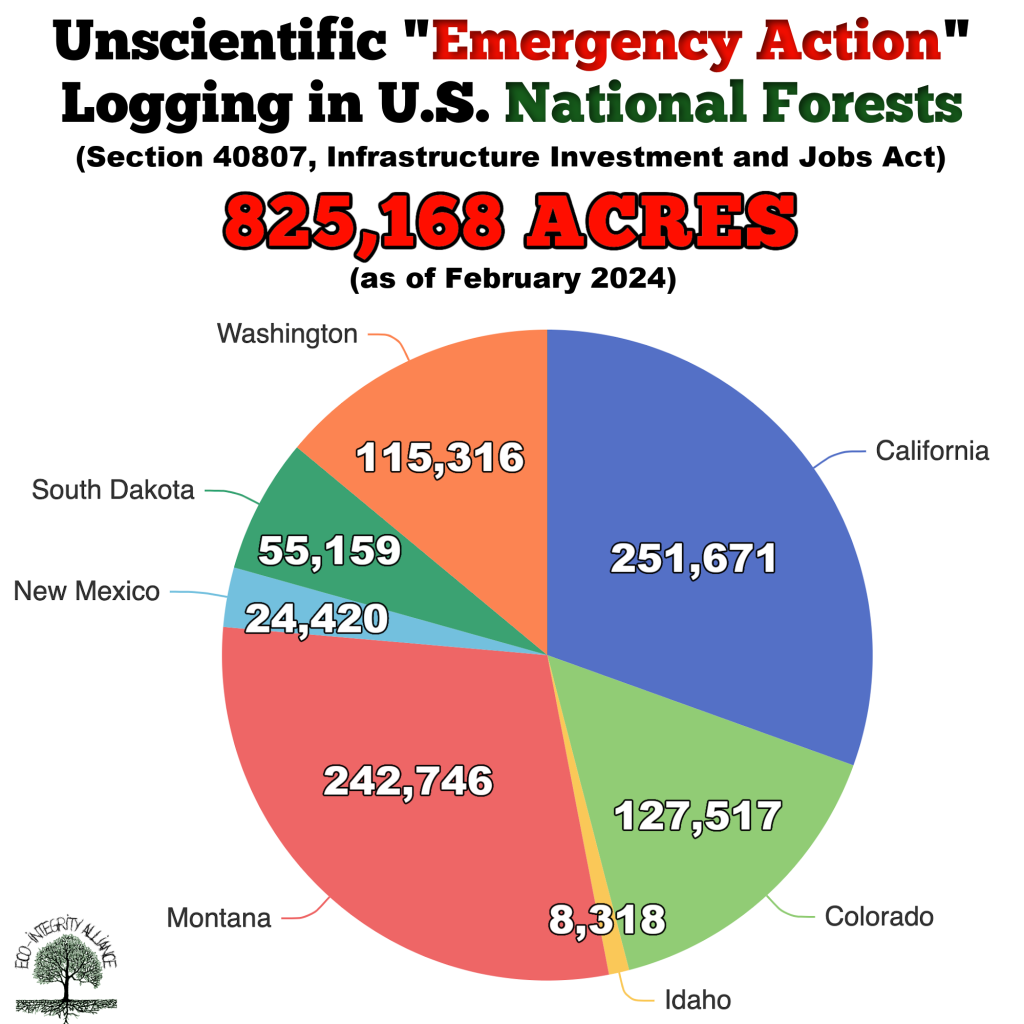As of February 1, 2024, 825,168 acres of unscientific “emergency action” logging has been approved or proposed across National Forests in California, Colorado, Idaho, Montana New Mexico, South Dakota and Washington.

In January 2023, President Biden’s Secretary of Agriculture Tom Vilsack invoked a controversial “emergency action” authorization, as laid out under Section 40807 of the Infrastructure Investment and Jobs Act of 2021, targeting up to 45 million acres of National Forests across the western U.S.
This so-called “emergency” logging, under the guise of “wildfire fuel reduction,” skirts the objection period of what’s known as the “predecisional administrative review process,” a legal challenge used by environmental advocates to pause or stop destructive projects, while bypassing alternative actions required by the National Environmental Policy Act (NEPA).
This unprecedented scale of logging not only ignores President Biden’s executive order to protect old growth forests, it would release an estimated 4 gigatons of carbon dioxide (90 tons of CO2 released per acre), the equivalent of 635 coal plants and greater than the entire U.S. emissions goal of 3.3 gigatons for 2030.
Despite one-sided and typically inaccurate media coverage, industry/agency claims of “overgrown” forests, unusual high-severity wildfire, and the efficacy of “wildfire fuel reduction” logging have been challenged and/or debunked by countless studies in peer-reviewed journals from scientists without conflicts of interest.
Indeed, these studies conclude that western forests prior to fire suppression did grow densely, did experience high-severity wildfire, and that not only won’t logging stop large wildfires, tree removal can make them burn hotter and spread faster by opening forests to the drying and heating effects of sunlight and wind. Indeed, more and more studies find that the largest wildfires aren’t the result of density of “fuels” (aka trees) but instead high temperatures, drought, and wind.
Thankfully, research, including from the U.S. Forest Service’s Rocky Mountain Research Station Fire Sciences Laboratory has shown that hardening homes—measures such as installing non-flammable roofs, screening vents, and maintaining defensible space 15-60 feet around structures—can save the vast majority from even the most intense wildfires.
Please sign the petition to encourage your members of Congress to protect our carbon-storing forests by stopping this taxpayer-funded unscientific “emergency” logging and protect our communities by funding home hardening grants instead.
People should NEVER kill trees for ANY reason, period. It’s totally immoral to kill anything you don’t eat, and people don’t eat trees. If you’re that scared of forest fires, don’t live in or near a forest, simple as that. And BTW, around 90% of wildfires are started by humans, so how about doing something about that instead of killing trees and destroying habitats & ecosystems?
LikeLike
Th largest and most destructive Colorado fire (economically) and killed 2 people was 2/12 years ago in Boulder County.
Forest conditions or forest fire research doesn’t talk to this issue. The front range of Colorado: Lakewood, Roxborough, Highlands Ranch, Castle Rock, Monument, US Air Force Academy and many other communities are rated with high risk of fire damage or destruction of thousands of homes and buildings.
LikeLike
Yes, all of the forest-edge communities are at “high risk,” which is why we strongly advocate for more home hardening grants to communities, the only approach scientifically proven to protect homes and lives. Instead, nearly all of the funding is going towards logging, which not only doesn’t protect communities, can actually increase the risk.
LikeLike